Vela constellation lies in the southern hemisphere. Its name means “the sails” in Latin. The constellation represents the sails of the Argo Navis, the ship on which Jason and the Argonauts sailed on their quest for the Golden Fleece. It was once part of the much larger constellation Argo Navis, which was divided into three smaller constellations – Vela (the sails), Carina (the keel) and Puppis (the stern) – by the French astronomer Nicolas Louis de Lacaille in the 1750s.
Argo Navis was one of the 48 Greek constellations, first catalogued by the Greek astronomer Claudius Ptolemy in the 2nd century CE.
Vela contains a number of interesting stars and deep sky objects, among them the Southern Ring Nebula (NGC 3132), the Gum Nebula, the Vela Supernova Remnant, the Pencil Nebula (NGC 2736), and the Omicron Velorum Cluster (IC 2391).
Facts, location and map
Vela is the 32nd constellation in size, occupying an area of 500 square degrees. It is located in the second quadrant of the southern hemisphere (SQ2) and can be seen at latitudes between +30° and -90°. The neighboring constellations are Antlia, Carina, Centaurus, Puppis and Pyxis.
The constellation name Vela is pronounced /ˈviːlə/. In English, the constellation is known as the Sails. The genitive form of Vela, used in star names, is Velorum (pronunciation: /vɪˈlɔːrəm/). The three-letter abbreviation, adopted by the International Astronomical Union (IAU) in 1922, is Vel.
Vela belongs to the Heavenly Waters family of constellations, along with Carina, Columba, Delphinus, Equuleus, Eridanus, Piscis Austrinus, Puppis and Pyxis.
Vela contains seven stars with known planets and has no Messier objects. The brightest star in the constellation is Gamma Velorum, with an apparent magnitude of 1.75. There are three meteor showers associated with the constellation: the Delta Velids, the Gamma Velids, and the Puppid-Velids.
Vela contains seven named stars. The names of stars that have been officially approved by the International Astronomical Union (IAU) are Alsephina (Delta Velorum Aa), Añañuca (GJ 367), Kalausi (HD 83443), Markeb (Kappa Velorum), Natasha (HD 85390), Suhail (Lambda Velorum), and Wattle (WASP-19).
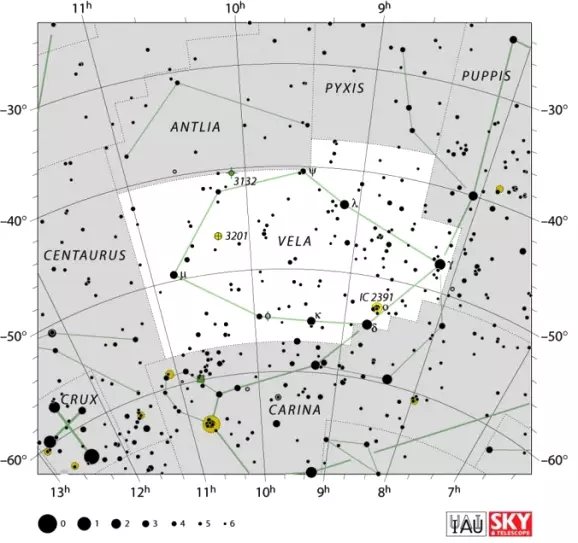
Vela constellation map by IAU and Sky&Telescope magazine
Vela myth
Vela represents the sails of the Argo Navis, the ship on which Jason and the Argonauts sailed from Iolcus to get the Golden Fleece. The ship was named after Argus, the shipwright who built it. It was said that the ship was constructed with the help of the goddess Athena. Once the expedition was a success, Argo was consecrated to the sea god Poseidon and then turned into a constellation.
Vela used to be part of the larger Greek constellation Argo Navis along with the constellations Puppis and Carina, which represented the stern and keel of the ship. Argo Navis was divided into the three smaller constellations in 1752 by the French astronomer Nicolas Louis de Lacaille.
Lacaille only used one set of Greek letters for all three constellations, which is why Vela does not have any stars designated Alpha or Beta. The stars that were designated Alpha and Beta in the constellation Argo Navis now belong to Carina constellation.
Vela stars
Regor – γ Velorum (Gamma Velorum)
Gamma Velorum is the brightest star in Vela constellation. It has an apparent magnitude of 1.7. Gamma Velorum is in fact a multiple star system composed of at least six stars, approximately 336 light years distant from Earth.
The star system’s traditional name, Suhail or Suhail al Muhlif, is derived from the Arabic suhayl al-muħlif, which means “the glorious (star) of the oath.” In modern times, the star has also been known as Regor, but neither name has been formally approved for Gamma Velorum by the International Astronomical Union (IAU).
The primary component in the system, Gamma-2 Velorum or Gamma Velorum A, is a spectroscopic binary star composed of a blue supergiant with the stellar classification of O7.5 and a massive Wolf-Rayet star, an evolved, exceptionally hot, massive star which is rapidly losing mass as a result of a very strong stellar wind. The Wolf-Rayet star is one of the nearest supernova candidates to Earth and will likely end its life as a Type Ic supernova. The two stars orbit each other with a period of 78.5 days and are separated by 1 astronomical unit.
The nearest companion to the binary star, Gamma-1 Velorum or Gamma Velorum B, is a blue-white class B subgiant star. Other components of the system are Gamma Velorum C, a white star with a visual magnitude of 8.5, and another binary star composed of Gamma Velorum D and Gamma Velorum E. Gamma Velorum D is another white, class A star with an apparent magnitude of 9.4, and Gamma Velorum E is a 13th magnitude star.
Alsephina – δ Velorum (Delta Velorum)
Delta Velorum is the second brightest star in the constellation. It has an apparent magnitude of 1.96 and is 80.6 light years distant from the Sun. It is located near the border with the constellation Carina.
Delta Velorum is another multiple star system. It is composed of Delta Velorum A and Delta Velorum B, which have a wide orbit and a 142 year orbital period. Delta Velorum A has a visual magnitude of 1.97 and Delta Velorum B has a magnitude of 5.55. The primary component is itself a spectroscopic binary star with an orbital period of 45.15 days. It is the brightest eclipsing binary star system known. Both stars in the system have evolved away from the main sequence. Both are rapid spinners and believed to be about 400 million years old.
Another binary system can be found at a separation of 69 arc seconds. It consists of an 11th magnitude and 13th magnitude stars separated by 6 seconds of arc.
The brightest component of the Delta Velorum system is formally named Alsephina, derived from the Arabic word for “the ship,” and sometimes also known as Koo She, which is Chinese for “bow and arrows.”
Suhail – λ Velorum (Lambda Velorum)
Lambda Velorum is the third brightest star in Vela. It has an apparent magnitude of 2.21 and is approximately 545 light years distant from Earth. It shared the traditional name Suhail with the brighter Gamma Velorum until the name was formally approved for the Lambda star by the International Astronomical Union (IAU) in 2016. In China, the star is known as Pinyin, which means “judge for estimating the age of animals.”
Lambda Velorum has the stellar classification of K4.5Ib-II, which means that it is an orange star halfway between the bright giant and supergiant stages. It is classified as an LC-type slow irregular variable star. It exhibits variations in brightness ranging from apparent magnitude 2.14 to 2.30.
The star is about 8.5 times more massive than the Sun and 10,000 times more luminous. It is believed to be about 32 million years old. It has a radius 207 times solar.
Markeb – κ Velorum (Kappa Velorum)
Kappa Velorum is a spectroscopic binary star approximately 572 light years distant from Earth. It has a visual magnitude of 2.48 and has the combined stellar classification of B2 IV, matching a blue-white subgiant star.
The two stars in the system orbit each other with a period of 116.65 days.
The star has the traditional name Markab (spelled Markeb to distinguish it from Alpha Pegasi in Pegasus constellation). The name is derived from the Arabic word markab, which means “something to ride.”
μ Velorum (Mu Velorum)
Mu Velorum is another binary star in Vela constellation. It is approximately 117 light years distant from Earth. The two components orbit each other with a period of 116.24 years and are separated by 1.437 seconds of arc. The system has a combined apparent magnitude of 2.69, and the individual stars have visual magnitudes of 2.7 and 6.4.
The brighter component is a yellow giant star with the stellar classification of G5 III. It is about 107 times more luminous than the Sun, has 3.3 times the mass, and 13 times the solar radius. The companion is also a class G (yellow) star, a main sequence dwarf belonging to the stellar class G2V.
N Velorum (HD 82668)
N Velorum is an orange giant star with the stellar classification K5 III. It has an apparent magnitude of 3.16 and is approximately 239 light years distant from the Sun. The star lies on the border between Vela and Carina. It is twice as massive as the Sun and has 29 times the solar radius.
φ Velorum (Phi Velorum)
Phi Velorum is a blue-white supergiant with the stellar classification B5 Ib. It has an apparent magnitude of 3.52 and is approximately 1,590 light years distant from the Sun. The star has the traditional name Tseen Ke, which means “record of heaven” or “star chart” in Chinese.
ο Velorum (Omicron Velorum)
Omicron Velorum is a blue-white subgiant belonging to the stellar class B3 IV. It has an apparent magnitude of 3.60 and is approximately 490 light years distant from the solar system. The star has a mass 5.5 times that of the Sun and a radius 4.3 times solar. It is 1,000 times more luminous than the Sun.
Omicron Velorum is classified as a variable star. Its luminosity varies from magnitude 3.55 to 3.67 over a period of 2.78 days.
ψ Velorum (Psi Velorum)
Psi Velorum is another binary star in Vela. It has an apparent magnitude of 3.60 and is 60.5 light years distant from the Sun. It is the nearest star to Earth located in Vela constellation.
The binary system consists of a yellow-white subgiant with the stellar classification of F3IV and a visual magnitude of 4.1, and a yellow-white main sequence dwarf belonging to the stellar class F0V with an apparent magnitude of 4.6.
The stars orbit each other with a period of 33.99 years and are separated by 0.68 arc seconds.
WISE 1049-5319
WISE 1049-5319 is a binary brown dwarf system only 6.6 light years distant from the Sun – the nearest known brown dwarfs to the solar system. It is also the nearest system to the Sun discovered since 1916, when Barnard’s Star was discovered in Ophiuchus constellation.
The primary component has the stellar classification of L8 ± 1. The two stars have an orbital period of about 25 years and orbit each other at a distance of about 3 astronomical units.
The system was discovered by the astronomer Kevin Luhman from Pennsylvania State University, and the discovery was announced on March 11, 2013.
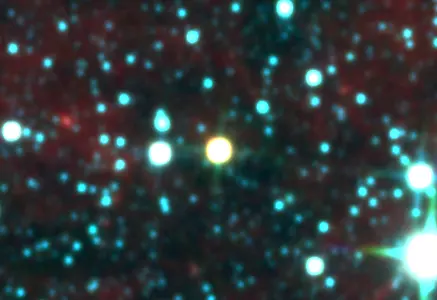
A multi-color WISE image centered on the binary brown dwarf WISE 1049-5319. The binary appears as a yellow disk — the individual brown dwarfs are not resolved. Image: NASA, IPAC
HD 78004 (c Velorum)
HD 78004 is an orange giant star with the stellar classification of K2III. It has an apparent magnitude of 3.75 and an absolute magnitude of -1.14. The star is approximately 309 light years distant from the solar system.
HD 74180
HD 74180 is another binary star in Vela. It has a combined stellar classification of F3Ia and a visual magnitude of 3.77. The primary component in the system is a yellow-white supergiant classified as an irregular variable. Its brightness varies from magnitude 3.77 to 3.91. The companion is a 10th magnitude star separated from the primary by 37.5 arc seconds.
HD 74180 is approximately 3.100 light years distant from Earth.
HD 92139
HD 92139 is a triple star system about 86.5 light years from Earth. It has a combined apparent magnitude of 3.84. The primary component is a yellow-white subgiant with the stellar classification of F3IV and an apparent magnitude of 4.5. It is a spectroscopic binary star with the two components orbiting each other every 10.21 days. The third star in the system is a white main sequence dwarf belonging to the stellar class A6V. The dwarf has a visual magnitude of 5.1 and is separated from the main pair by 0.3 seconds of arc. It orbits the pair with a period of 16.3 years.
HD 75063
HD 75063 is a white giant star belonging to the spectral class A1III. It has a visual magnitude of 3.87 and is approximately 1,550 light years distant from Earth. The star has an absolute magnitude of -4.54.
HD 73526
HD 73526 is a yellow main sequence dwarf belonging to the stellar class G6V. It has an apparent magnitude of 9.00 and is approximately 310 light years distant from the solar system. The star has roughly the same mass as the Sun and 1.49 times the solar radius. It is 1.77 times more luminous than the Sun.
Two planets are known to be orbiting the star. The first one, discovered in 2002, has an orbital period of 187.5 days and the second one, first observed in 2006, completes an orbit around the star every 376.9 days. The planets form a 2:1 resonance: whenever the inner one completes two orbits, the outer one completes one. The inner planet, HD 73526 b, has a mass at least 2.07 times that of Jupiter and the outer one, HD 73526 c, has at least 2.30 Jupiter masses.
WASP-19
WASP-19 is a yellow main sequence dwarf belonging to the stellar class G8V. It has an apparent magnitude of 12.3 and is about 815 light years distant from the Sun.
A hot Jupiter-type planet, WASP-19 b, was discovered orbiting the star in 2009. The planet has the shortest orbital period found so far, only 0.78884 days.
V390 Velorum
V390 Velorum is an old, massive red giant star with the stellar classification F3e. The star has evolved from the red giant stage and started to throw its hull off, which formed a disk of dust that will eventually form a planetary nebula.
It is about 5,000 times more luminous than the Sun, and approximately 2,600 light years distant from Earth. It has a visual magnitude of 10.48. The star is classified as an RV Tauri type variable. It has a companion that completes an orbit around it every 499 days.
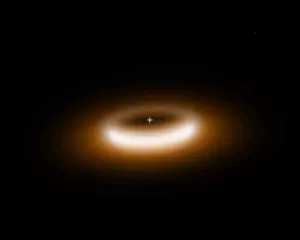
Circumstellar disk around binary star V390 Velorum (IRAS 08544), image: ESO
Asterisms
False Cross
The False Cross is an asterism formed by the stars Alsephina (Delta Velorum), Markeb (Kappa Velorum), Aspidiske (Iota Carinae) and Avior (Epsilon Carinae) in Carina constellation. It was named the False Cross because it is often mistaken for the Southern Cross, which is frequently used in navigation to find true south.
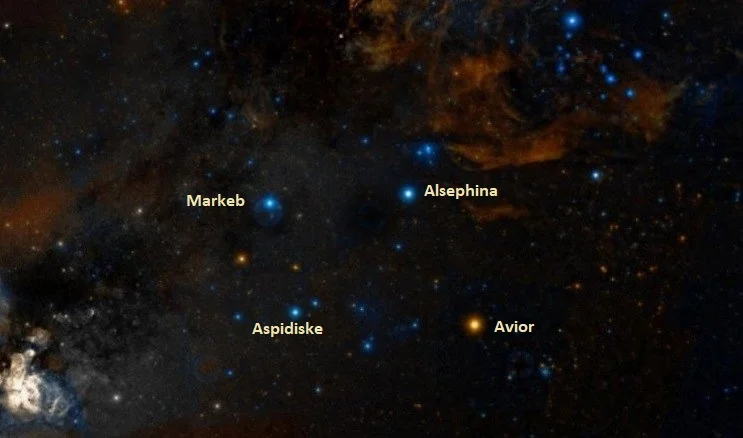
The stars of the False Cross, image: Wikisky
Deep sky objects in Vela
Eight-Burst Nebula (Southern Ring Nebula) – NGC 3132 (Caldwell 74)
NGC 3132 is a bright planetary nebula in Vela, almost half a light year in diameter. It has an apparent magnitude of 9.87 and is approximately 2,000 light years distant from the Sun. It was named the Eight-Burst Nebula because it appears like the figure 8 in amateur telescopes. The nebula’s resemblance to the Ring Nebula (Messier 57) has earned it the nickname the Southern Ring Nebula.
The nebula was one of the first targets of the James Webb Space Telescope (JWST) in 2022. It contains two stars, a 10th magnitude star and a 16th magnitude white dwarf that has blown off its outer layers and whose ultraviolet radiation makes the nebula glow.
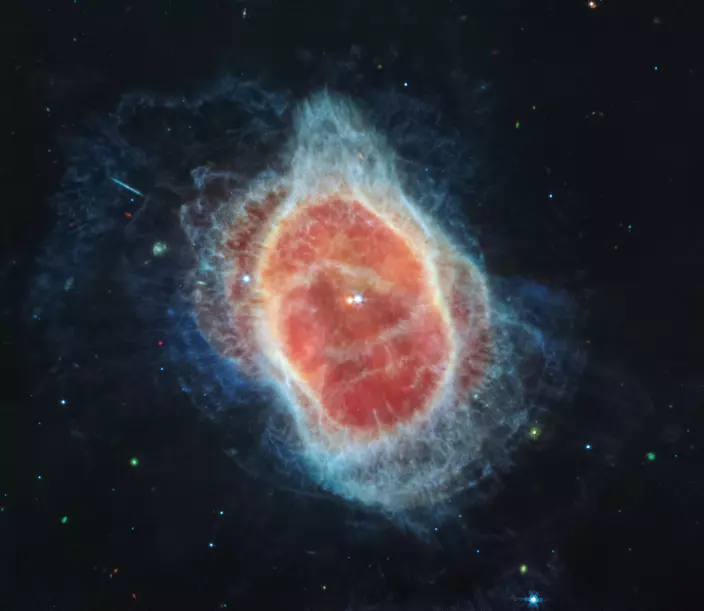
The Southern Ring Nebula – This Mid-Infrared Instrument (MIRI) image also offers an incredible amount of detail, including a cache of distant galaxies in the background. Most of the multi-colored points of light are galaxies, not stars. Tiny triangles mark the circular edges of stars, including a blue one within the nebula’s red bottom-most edges, while galaxies look like misshapen circles, straight lines, and spirals. Credit: NASA, ESA, CSA, STScI
Vela Supernova Remnant (Gum 16)
The Vela Supernova Remnant is, as the name says, a supernova remnant in Vela constellation. It has an apparent magnitude of 12 and is approximately 815 light years distant from Earth. It is about 8 degrees in size. The progenitor star is believed to have gone supernova about 11,000 – 12,300 years ago.
The remnant includes the Pencil Nebula (NGC 2736) and is associated with the Vela Pulsar.
The Vela Supernova Remnant overlaps the Puppis Supernova Remnant in Puppis constellation, which is four times more distant. Both objects are among the brightest, largest X-ray features in the night sky.
In 1998, another supernova was observed in the direction of the Vela remnant, RX J0852.0-4622, approximately 650 light years from Earth.
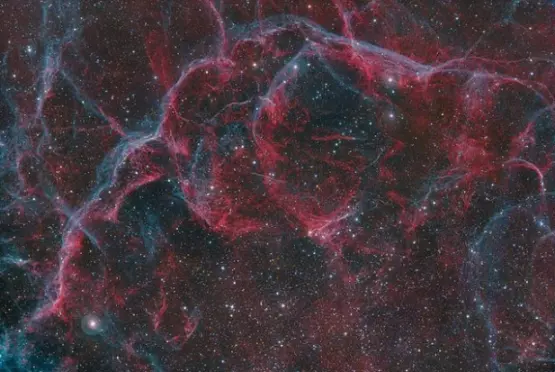
Long exposure photograph of the Vela Supernova Remnant, taken from the Kalahari Desert in Namibia. This image shows the supernova remnant’s northern section. The location of the Vela Pulsar, which is the origin of the supernova remnant, is approximately indicated by the annotation. North is to the left. Image: Harel Boren (CC BY-SA 4.0)
Vela Pulsar (PSR B0833-45)
The Vela Pulsar is a pulsar associated with the Vela Supernova Remnant. The association, made by astronomers at the University of Sydney in 1968, was evidence that supernovae form neutron stars.
The pulsar is a source of radio, optical, gamma and X-ray emissions. It has an apparent magnitude of 23.6 and is approximately 959 light years distant from the solar system.
Pencil Nebula – NGC 2736
NGC 2736 is a nebula located near the Vela Pulsar in the Vela Supernova Remnant, approximately 815 light years from Earth. It is believed to have been formed from part of the shock wave of the supernova remnant. It has an apparent magnitude of 12.
The nebula was discovered by the English astronomer John Herschel on March 1, 1835 from the Cape of Good Hope.
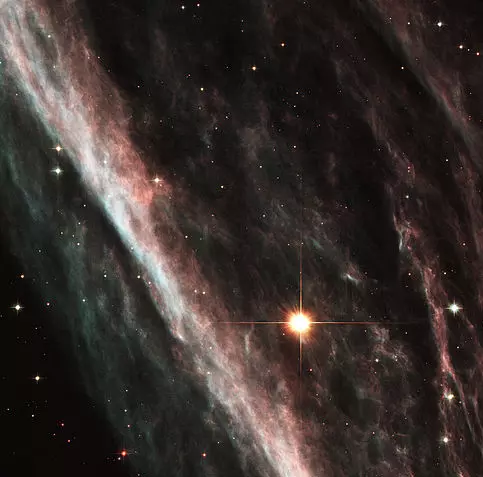
Remnants from a star that went supernova thousands of years ago created a celestial abstract portrait, as captured in this NASA Hubble Space Telescope image of the Pencil Nebula. Officially known as NGC 2736, the Pencil Nebula is part of the huge Vela supernova remnant, located in the southern constellation Vela. Discovered by Sir John Herschel in the 1840s, the nebula’s linear appearance triggered its popular name. The nebula’s shape suggests that it is part of the supernova shock wave that recently encountered a region of dense gas. It is this interaction that causes the nebula to glow, appearing like a rippled sheet. In this image, astronomers are looking along the edge of the undulating sheet of gas. This view shows large, wispy filamentary structures, smaller bright knots of gas, and patches of diffuse gas. The Hubble Heritage Team used the Advanced Camera for Surveys in October 2002 to observe the nebula. The region of the Pencil Nebula captured in this image is about three fourths of a light-year across. The Vela supernova remnant is 114 light-years (35 parsecs) across. The remnant is about 815 light-years (250 parsecs) away from our solar system. Image: NASA and The Hubble Heritage Team
Gum Nebula (Gum 12)
The Gum Nebula is an emission nebula spanning about 40 degrees in the constellations Vela and Puppis, about 400 parsecs from Earth. It contains the Vela Supernova Remnant and is itself believed to be a greatly expanded remnant of a supernova that occurred about a million years ago.
The nebula was discovered by the Australian astronomer Colin Stanley Gum in the 1950s and named after him.
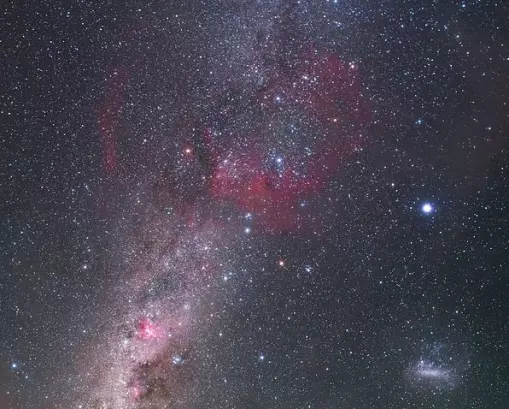
Gum Nebula visible at the background of the Milky Way, with Large Magellanic Cloud in the bottom right for scale. The brightest star in this view is Canopus. Image: P. Horálek/ESO
Gum 19
Gum 19 is a star-forming region in Vela, approximately 22,000 light years from Earth. The nebula is illuminated by the large, hot blue supergiant star V391 Velorum. The star has a surface temperature of 30,000 degrees Celsius.
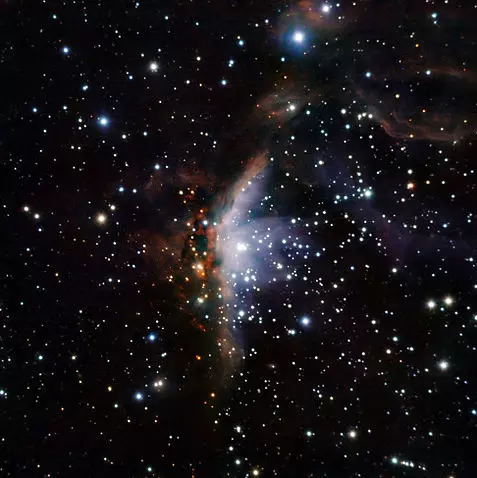
The furnace that fuels Gum 19’s luminosity is a gigantic, superhot star called V391 Velorum. Shining brightest in the scorching blue range of visible light — V391 Velorum boasts a surface temperature in the vicinity of 30 000 degrees Celsius. Within the neighbourhood of this fitful supergiant, new stars nonetheless continue to grow. In several million years — a blink of an eye in cosmic time — they will eventually reach the high density at their centres necessary to ignite nuclear fusion. The fresh outpouring of energy and stellar winds from these newborn stars will also modify the gaseous landscape of Gum 19. Image: ESO
NGC 2670
NGC 2670 is an open cluster in Vela. It has an apparent magnitude of 7.8 and is approximately 3,200 light years distant from the Sun. It consists of about 50 moderately bright stars.
NGC 2899
NGC 2899 is a planetary nebula about 6,500 light years from Earth. It was discovered by John Herschel in 1835.
NGC 2547
NGC 2547 is an open cluster about 1,500 light years from Earth. It has an apparent magnitude of 4.7. It was discovered by Nicolas Louis de Lacaille in 1751 during his expedition to the Cape of Good Hope in South Africa.
The stars in the cluster are believed to be 20 to 35 million years old.
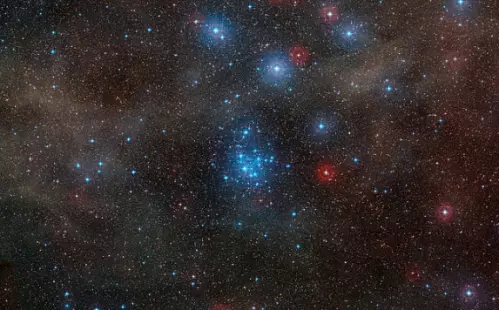
The rich region of sky around the young open star cluster NGC 2547 in the southern constellation of Vela (The Sail). Image: ESO/Digitized Sky Survey 2
NGC 3201 (Caldwell 79)
NGC 3201 is a globular cluster with a visual magnitude of 8.24. It is about 16,300 light years distant from Earth. The cluster is about 10.24 billion years old and composed mainly of old stars. It is about 40 light years in radius and dominated by red giants.
NGC 3201 was discovered by the Scottish astronomer James Dunlop on May 28, 1826.
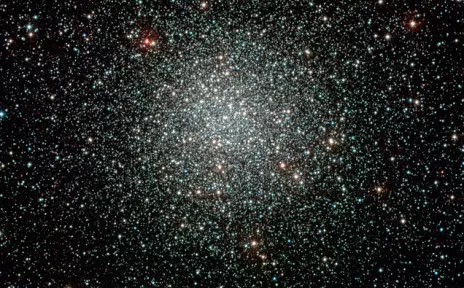
Colour-composite image of the globular cluster NGC 3201, obtained with the WFI instrument on the ESO/MPG 2.2-m telescope at La Silla. Globular clusters are large aggregates of stars, that can contain up to millions of stars. They are among the oldest objects observed in the Universe and were presumably formed at about the same time as the Milky Way Galaxy, in the early phase after the Big Bang. This particular globular cluster is located about 16 000 light-years away towards the Southern Vela constellation. The data were obtained as part of the ESO Imaging Survey (EIS), a public survey being carried out by ESO and member states, in preparation for the VLT First Light. The original image and astronomical data can be retrieved from the EIS Pre-Flames Survey Data Release pages, where many other nice images are also available. Image: ESO
HH 47 (Herbig Haro 47)
HH 47 is a Herbig-Haro object in Vela constellation. It is a patch of nebulosity formed as a result of a young star ejecting narrow jets of gas which then collide with nearby gas and dust clouds.
HH 47 is approximately 1,500 light years distant from Earth.
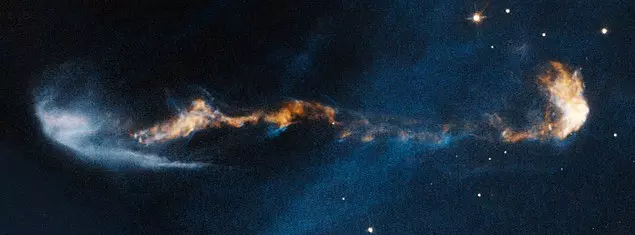
The glowing, clumpy chains of material shown in these NASA/ESA Hubble Space Telescope images are the signposts of star birth. Ejected episodically by young stars like cannon salvos, the blobby material zips along at more than 700 000 kilometres per hour. The speedy jets are confined to narrow beams by the powerful stellar magnetic field. Called Herbig-Haro or HH objects, these outflows have a bumpy ride through space. When fast-moving blobs collide with slower-moving gas, bow shocks arise as the material heats up. Bow shocks are glowing waves of material similar to waves produced by the bow of a ship ploughing through water. In HH 47, the blobs of material look like a string of cars on a crowded motorway, which ends in a chain-reaction accident. The smash up creates the bow shock, left. Image: NASA, ESA, and P. Hartigan (Rice University)
Omicron Velorum Cluster – IC 2391 (Caldwell 85)
IC 2391 is a young open cluster in Vela, approximately 500 light years from Earth. It has an apparent magnitude of 2.5 and can be seen without binoculars.
The cluster consists of about 30 stars and spans 50 arc minutes.
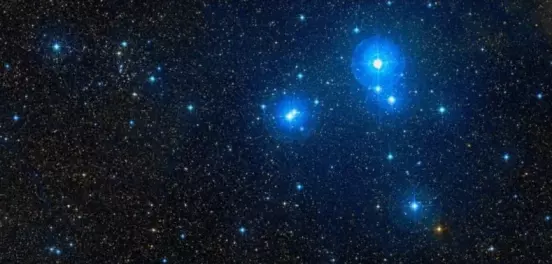
The Omicron Velorum Cluster (IC 2391) and NGC 2669, image: Wikisky